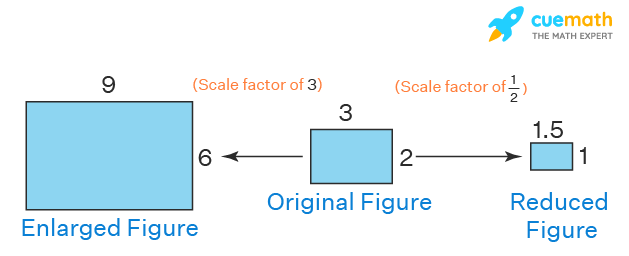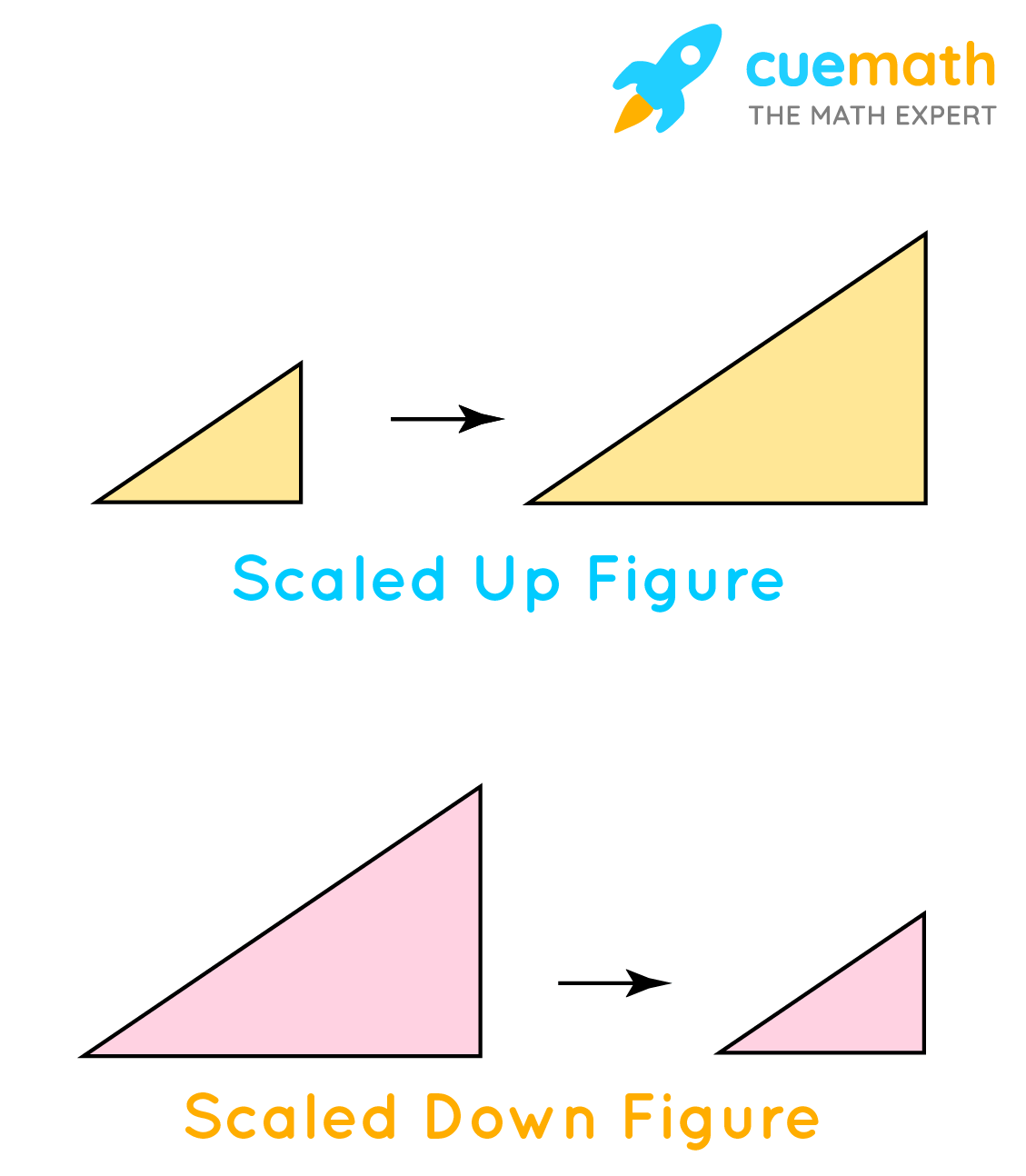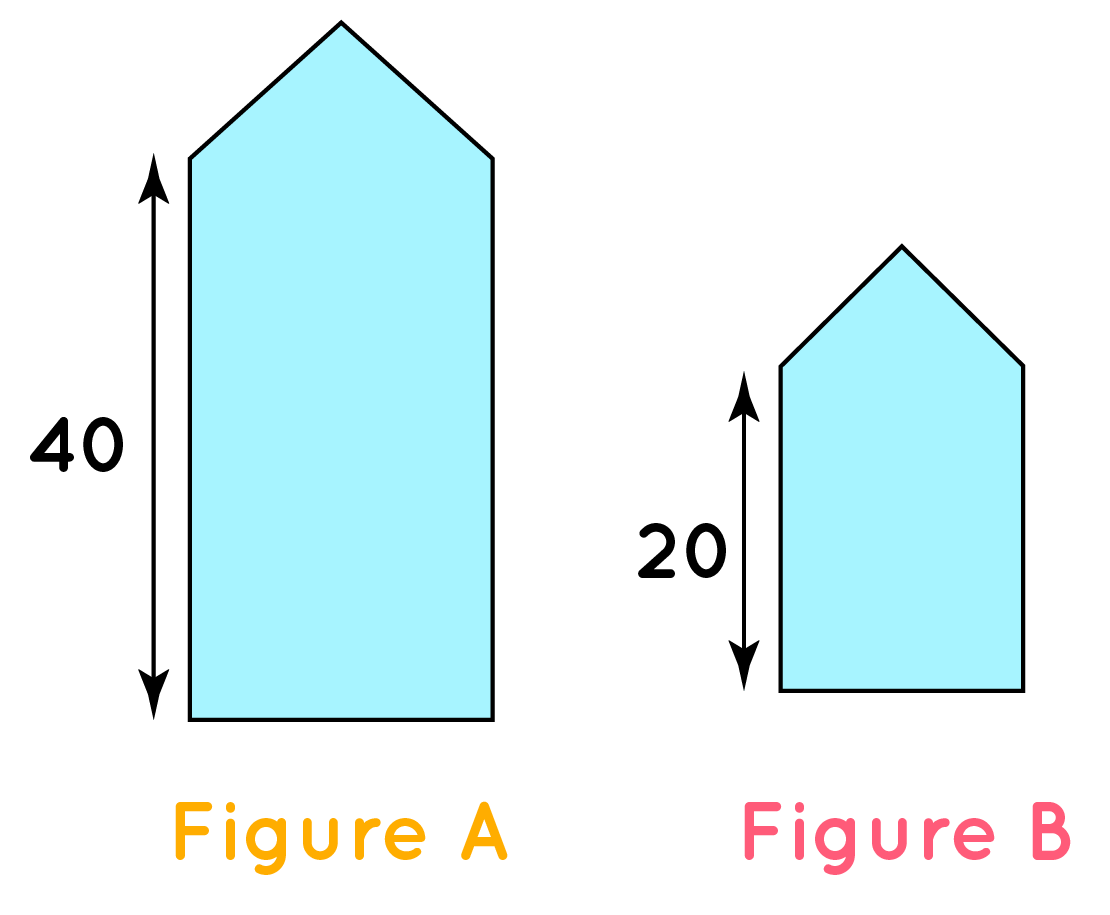Scale Factor
Scale factor is a number by which the size of any geometrical figure or shape can be changed with respect to its original size. It is used to draw the enlarged or reduced shape of any given figure and to find the missing length, area, or volume of an enlarged or reduced figure. It should be noted that the scale factor helps in changing the size of the figure and not its shape.
| 1. | What is a Scale Factor? |
| 2. | Scale Factor Formula |
| 3. | How to Find the Scale Factor? |
| 4. | FAQs on Scale Factor |
What is a Scale Factor?
Scale factor is defined as the number or the conversion factor which is used to change the size of a figure without changing its shape. It is used to increase or decrease the size of an object. The scale factor can be calculated if the dimensions of the original figure and the dimensions of the dilated (increased or decreased) figure are known. For example, a rectangle has a length of 5 units and a width of 2 units. Now, if we increase the size of this rectangle by a scale factor of 2, the sides will become 10 units and 4 units, respectively. Hence, we can use the scale factor to get the dimensions of the changed figures.
Observe the following figure which shows how the scale factor can change the original figure to its larger and smaller versions. In the following figure, the original rectangle has the dimensions given as 3 units and 2 units. To create an enlarged figure, the dimensions are multiplied by the scale factor of 3 using the formula: Dimensions of the new shape = Dimensions of the original shape × Scale factor. This gives the new dimensions as 9 units and 6 units respectively. Similarly, to create a reduced figure, we multiply the original dimensions with the scale factor of 1/2. This gives the reduced dimensions as 1.5 units and 1 unit.

Scale Factor Formula
The basic formula to find the scale factor of a figure is expressed as,
Scale factor = Dimensions of the new shape ÷ Dimensions of the original shape.
This formula can also be used to calculate the dimensions of the new figure or the original figure by simply substituting the values in the formula.
How to Find the Scale Factor?
The scale factor can be calculated when the new dimensions and the original dimensions are given. However, there are two terms that need to be understood when using the scale factor. When the size of a figure is increased, we say that it has been scaled up and when it is decreased, we say that it has scaled down.
Scale Up
Scaling up means that a smaller figure is enlarged to a bigger one. In this case, the scale factor can be calculated by a formula, which is another version of the basic formula given in the previous section.
Scale factor = Larger figure dimensions ÷ Smaller figure dimensions
The scale factor for scaling up is always greater than 1. For example, if the dimension of the larger figure is 15 and that of the smaller one is 5, let us place this in the formula which makes it: 15 ÷ 5 = 3. Thus, we can see that the scale factor is greater than 1.
Scale Down
Scaling down means that a larger figure is reduced to a smaller one. Even in this case, the scale factor can be calculated by a formula, which is another version of the basic formula.
Scale factor = Smaller figure dimensions ÷ Larger figure dimensions
The scale factor for scaling down is always less than 1. For example, if the dimension of the smaller figure is 8 and that of the larger one is 24, let us place this in the formula which makes it: 8 ÷ 24 = 1/3. Thus, we can see that the scale factor is less than 1.
Observe the following triangles which explain the concept of a scaled-up figure and a scaled-down figure.

Important Notes
The following points should be remembered while studying about the scale factor:
- The scale factor of a dilated figure is denoted by 'r' or 'k'.
- If the scale factor is more than 1 (k > 1), the image is enlarged.
- If the scale factor is less than 1 (0< k <1), the image is contracted.
- If the scale factor is 1 (k = 1), the image remains the same.
- The scale factor cannot be zero.
☛ Related Articles
Scale Factor Examples
-
Example 1. Write the correct scale factor formulas for the following situations.
a) If the image has to be enlarged.
b) If the image has to be reduced.Solution:
a) If the image has to be enlarged, the scale factor is more than 1 (k > 1). This means the image is scaled up.
The scale factor formula = Larger figure dimensions ÷ Smaller figure dimensionsb) If the image needs to be reduced, the scale factor is less than 1 (0<k<1). This means the image is scaled down.
The scale factor formula = Smaller figure dimensions ÷ Larger figure dimensions -
Example 2. There are two similar polygons as shown below. Find the scale factor used to create the smaller polygon.

Solution: The given dimension of the bigger polygon is 40 units. The given dimension of the smaller polygon is 20 units. Here, the figure is scaled down.
The scale factor = Smaller figure dimensions ÷ Larger figure dimensions = 20/40 = 1/2.
Therefore, the scale factor used to create the smaller polygon is 1/2. -
Example 3. A triangle was increased by a scale factor of 2 resulting in the new dimensions as 6 units by 10 units by 12 units. Find the dimensions of the original triangle.
Solution:
The new dimensions of the triangle are: 6 units; 10 units; and 12 units; The scale factor = 2
Scale factor = Dimensions of the new shape ÷ Dimensions of the original shape. Substituting the values in the formula for all the three dimensions:
a.) 2 = 6 ÷ Dimensions of the original shapeDimensions of the original shape = 6 ÷ 2 = 3 units
b.) 2 = 10 ÷ Dimensions of the original shape
Dimensions of the original shape = 10 ÷ 2 = 5 units
c.) 2 = 12 ÷ Dimensions of the original shape
Dimensions of the original shape = 12 ÷ 2 = 6 units
Therefore, the original dimensions of a triangle were = 3 units, 5 units, and 6 units

FAQs on Scale Factor
What is a Scale Factor?
Scale factor is a number that is used to draw the enlarged or reduced shape of any given figure. It is a number by which the size of any geometrical figure or shape can be changed with respect to its original size. It helps in changing the size of the figure but not its shape.
What Happens if the Scale Factor is Greater Than 1?
If the scale factor is more than 1 (k > 1), it means that the given figure needs to be enlarged.
What Does a Scale Factor of 0.5 Mean?
A scale factor of 0.5 means that the changed image will be scaled down. For example, the original figure of a square has one of its sides as 6 units. Now, let us use the scale factor of 0.5, to change its size. We will use the formula: Dimensions of the new shape = Dimensions of the original shape × Scale factor. Substituting the values in the formula: the dimensions of the new square will be = 6 × 0.5 = 3 units. This shows that a scale factor of 0.5 changed the figure to a smaller one.
How do you Find the Scale Factor?
The scale factor can be calculated when the new dimensions and the original dimensions are given. The basic formula to find the scale factor of a figure is: Scale factor = Dimension of the new shape ÷ Dimension of the original shape. For example, if the side length of a square is 6 units and if the size of the square has been increased such that the side length of the square becomes 18 units, let us find the scale factor. We will use the formula, Scale factor = Dimension of the new shape ÷ Dimension of the original shape. After substituting the given values we get, Scale factor = 18 ÷ 6 = 3. Therefore, the scale factor that is used to increase the size of the square is 3.
What Happens if the Scale Factor is Less Than 1?
If the scale factor is less than 1 (0< k <1), then the new image that is formed will be contracted or scaled-down. In other words, the new figure will have smaller dimensions as compared to the original figure after it is resized using the scale factor which is less than 1.
Where do we Use a Scale Factor?
Scale factor is a number by which the size of any geometrical figure or shape can be changed with respect to its original size. When things are too large, we use scale factors to calculate smaller, proportional measurements. It is used to compare two similar geometric shapes and also in other fields like cooking, where the ingredients can be reduced or increased according to the given situation. Scale factor can also be used to find any missing dimensions in similar figures.
What is the Formula For Scale Factor?
The basic formula that is used for calculating the scale factor is, Scale factor = Dimension of the new shape ÷ Dimension of the original shape. In case, if the original figure is scaled up, the formula is written as, Scale factor = Larger figure dimensions ÷ Smaller figure dimensions. When the original figure is scaled down, the formula is expressed as, Scale factor = Smaller figure dimensions ÷ Larger figure dimensions.
What Does a Negative Scale Factor Mean?
A negative scale factor makes the dilation rotate 180° and it creates an image on the other side of the centre of the enlargement.
What Scale Factor makes a Figure Smaller?
A scale factor which is less than 1 makes the original figure smaller. For example, let us use a scale factor of 1/3 to change the size of a figure with a given dimension of 36. We will place the given values in the formula: Scale factor = Dimension of the new shape ÷ Dimension of the original shape. Substituting the values, we get, 1/3 = Dimension of the new shape ÷ 36. After solving this, the dimension of the new shape is = 12. Since 12 is smaller than 36, it means the original figure has been reduced in size. Thus, it can be seen that the scale factor which is less than 1 makes a figure smaller.
How is a Scale Different from a Scale Factor?
- Scale is a ratio that is used to define the relation of the actual figure or object with its model. It is commonly used in maps to represent the actual figures in smaller units. For example, a scale of 1:3 means 1 on the map represents the size of 3 in the real world.
- Scale factor is a conversion factor - a number which is used to increase or decrease the size of a figure. For example, if a circle needs to be increased in size using a scale factor of 4, and the circumference of the circle is 7 units. What will be the circumference of the new enlarged circle? We will use the formula, Scale factor = Dimension of the new shape ÷ Dimension of the original shape. This can be written as, Dimension of the new shape = Scale factor × Dimension of the original shape. After substituting the given values, we will get, Dimension of the new shape = 7. After solving this, we get, Dimension of the new shape = 28 units.
visual curriculum